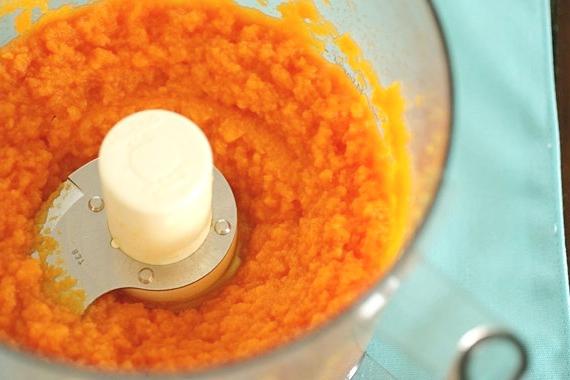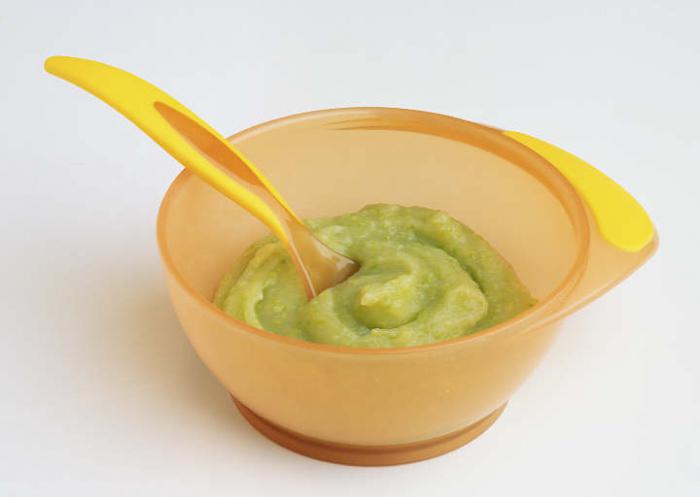For a newborn, the main food is mother's milk. He gets all the nutrients from it, but gradually there is a need to get used to regular food. It is important to know the features of complementary feeding at 6 months when breastfeeding so that the baby has fewer digestive problems.
Rules for introducing foods into the diet
The rules for introducing new products include a number of recommendations and restrictions that will help parents introduce their child to new taste sensations without any problems. First, you should study a number of general taboos that will make complementary feeding for 6-month-old children easier:
- You should not start taking new foods during the hot season or extreme heat.
- Vaccinations, diseases, illnesses and complementary feeding do not go together.
- Take your time, follow the “do no harm” rule! An immature digestive system cannot quickly absorb various foods.
- Do not introduce two or more products at the same time; complementary foods should be one-component.
- Do not force your child to eat any particular dish; it is better to offer an alternative solution that will suit both parties.
The first food is usually tasted in the morning to monitor the baby's reaction to it. To begin with, you can try one teaspoon, the next day two, bringing the amount of product to a full serving. After the child eats puree or porridge, offer him formula or breast milk, the sequence of actions should be exactly this. Be sure to monitor your baby’s stool and adjust the diet at the first sign of constipation or disorder.
Dairy products
Pediatricians have different opinions about products for first feeding. Most experts believe that fermented milk products can be introduced into a baby’s diet from 9 months. This is associated with a high calcium content - it contributes to the rapid overgrowth of the fontanel on the crown of the child.
Dr. Komarovsky recommends introducing low-fat kefir, about 10-20 g, into the baby’s diet first, gradually increasing the amount. He says that fermented milk products are more similar in structure to the baby’s usual diet, and their calcium content is no more than that of breast milk. Sudden changes in diet can cause disturbances in the digestive system, since pureed vegetables are very different from mother's milk.
After a few days, you can add a little low-fat cottage cheese, about 30 g, to the kefir. Stir the components thoroughly until smooth. The amount of cottage cheese should not be increased until 8 months of age, then you can increase it to a maximum of 50 g; you cannot give more at one time until the baby is 12 months old. This is a rather heavy product for children's digestion.
Cottage cheese should be chosen from a children's series with low fat content, without additives; it is better to prepare it yourself. To do this, heat the milk over low heat until it is lukewarm, add 4 tbsp. l. sour cream. Stir well, wrap, leave for 12-15 hours. Then bring the milk to a boil until it curdles and strain.
Fermented milk products restore intestinal microflora, normalize digestion and metabolism. They should not be given to children with kidney disease or casein intolerance.
How do you know when the time has come?
Feeding a child by month is considered the most correct and adapted to the child’s digestive system. We start with vegetables, then introduce porridge, cottage cheese and yolk, as well as meat and bread. However, each baby is individual and develops according to its own schedule. How can you understand that your beloved child is ready to start eating new food? Please note that the child must demonstrate interest in food, be able to hold his head upright and sit confidently; if he is unwilling, he may refuse the offered product. As a rule, all these conditions are met no earlier than six months. In some cases, according to the recommendations of the pediatrician, the introduction of products may be prescribed later or earlier.

First new dish
Complementary feeding of a 6-month-old infant should begin with vegetable dishes. The exception is cases where the baby is significantly underweight; in this scenario, the doctor will probably advise you to start getting acquainted with the world of new tastes with porridge.
Why are vegetables considered the optimal product for starting complementary feeding? The thing is that they have a very beneficial effect on the digestion process, as they contain fiber and vitamins, and also have a texture that is easy on the stomach. Start feeding your baby zucchini, cauliflower or broccoli. A little later, the daily menu can be supplemented with colored foods, pumpkin or carrots; they are considered more allergenic, so they are introduced some time after the start of complementary feeding.

You can buy jarred vegetable puree for your child, or you can make it yourself from fresh or frozen vegetables. Simply boil the product in water and then bring it to a smooth state using a blender, grater or meat grinder. At first, you should not add salt or vegetable oil to such a dish.
“Do no harm” is the basic rule of complementary feeding
In order for inexperienced parents to at least roughly navigate the issue of introducing complementary foods, there are special tables that indicate the main volumes of products used for this - they contain information about the needs of the baby at a certain age. However, it should be remembered that they do not take into account the individual characteristics of the child’s physical development and his temperament, nor the nutritional value of mother’s milk - and meanwhile, such factors can significantly influence the process of forming a new menu for a 6-month-old baby:
- The quality and quantity of breast milk determines the amount of complementary feeding. The recommended 150 g of porridge or vegetable puree at 6 months is the maximum amount that a child eats at one feeding. If the mother’s milk has sufficient nutritional value, the baby is unlikely to eat this volume completely, exchanging it for more familiar and, from his point of view, tasty food - at this age, complementary feeding is perceived by the child as an introduction to new products included in the adult menu. In this case, you should not forcefully “stuff” food into the child: as soon as he has lost interest in additional nutrition, you just need to offer him the breast so that he is completely satisfied;
- The temperament and physical condition of the child is another important factor on which the pace of introduction of complementary foods and its volumes depend. If a child is active and inquisitive, he is keenly interested in the world around him - accordingly, he spends more energy than his phlegmatic and more passive peer. Consequently, he needs more food to restore strength - which means that such a “live animal” has a better appetite, and the volume of food absorbed is somewhat larger. At the same time, the metabolic processes in the body of a 6-month-old baby are not yet “working at full strength”, and therefore the amount of food eaten may be different: if your baby enthusiastically ate 150 g of puree yesterday, but today he barely managed to eat only half of what was offered complementary feeding – no need to insist on yesterday’s “norm”.
Read also:
After giving birth, the doctor discovered a hematoma on the child’s head and did not treat it
The process of introducing complementary foods should be based on the child’s interest in learning about the world around him, the variety of colors, smells, tastes (including the variety of food products on the menu of other family members). The desire to imitate adults also plays an important role in this process.
Mothers of 6-month-old babies should not set themselves the task of replacing breastfeeding with complementary foods at any cost: they must remember that this is just a desire to acquaint the baby with the variety of food that awaits him a little later - when there really is breast milk it's not enough for him. Until then, you should leave the child the right to choose a diet, maintaining a certain balance between the two types of feedings: let the process of accustoming the child to the general menu goes parallel to breastfeeding - they are equally beneficial for the baby, and only their incorrect ratio can cause harm.
Getting to know porridge
The main purpose of porridge is nutrition. A hearty meal will allow your child to gain the required weight quickly. However, you should approach the choice of porridge with the utmost care. So, the product you choose in the store must be single-component, that is, contain only one grain, for example, buckwheat or rice. Please note that the packaging must be marked as gluten-free; such a protein quite often provokes allergic reactions in young children. You should also not choose cereals that contain milk, yogurt or sugar; any additives will be appropriate only after a few months. This is exactly how complementary feeding begins for a 6-month-old baby; porridge is a very important component.

Cook or buy?
Parents often argue whether it is worth giving their baby canned food and store-bought baby cereals. The advantages are as follows:
- Saving time on preparation;
- Variety of flavors and combinations;
- Content of additional vitamins and microelements;
- Balanced composition, adapted to the child’s age.
If you decide to buy ready-made complementary foods for your baby, you need to look at the expiration date: the food should be the freshest, it is unacceptable to buy an expired product or with corrections in the production date. The long shelf life indicated on the packaging indicates the content of preservatives. You need to carefully study the composition: the fewer components, the better. It is important to look at what age the food is intended for: manufacturers indicate it on the packaging.
When preparing food for your baby yourself, you can be sure of the quality and freshness of the product. You cannot store puree. For each feeding it is necessary to prepare a new portion.
About cottage cheese and eggs
After the first complementary foods are introduced to a 6-month-old child, it is time to expand his food interests. You can offer your baby baby cottage cheese or chicken yolk. When consuming such products, it is extremely important to comply with the norm. So, you should not give your baby yolks more than once a day and twice a week, and cottage cheese is calculated according to the scheme - a maximum of 5 grams per kilogram of the child’s weight. This product should also not be given every day at first. An excess of such dishes can lead to serious health problems, the development of allergies, and kidney damage.

Let's start eating meat
Proper complementary feeding for a 6-month-old child does not include meat; it appears much later, after 60-90 days. It could be rabbit, turkey or chicken, a little later lean beef or veal, the main thing is a minimum of fat. Meat will have to be present in the child’s diet every day, but in a certain dosage (about 3 – 5 grams per kilogram of the baby’s weight). You can use minced meat or grind the fillet using a meat grinder; special baby jars are also suitable for feeding your baby. Under no circumstances should you prepare meat broths; in modern pediatrics they are strictly prohibited.

Approximate nutrition plan for a 6 month old baby
So, let’s repeat what complementary feeding should look like for a 6-month-old baby. The menu for one day can be presented like this:
- First breakfast: breast milk or age-appropriate formula.
- Second breakfast: porridge (starting from one spoon and up to 200 g).
- Lunch: vegetable puree (starting from one spoon and up to 200 g).
- Afternoon snack: breast milk or age-appropriate formula.
- Dinner: breast milk or age-appropriate formula.
- Second dinner: breast milk or age-appropriate formula.
As you can see, complementary feeding for 6-month-old children is still quite monotonous, but in the very near future your baby will be able to enjoy kefir, fermented milk mixtures, and subsequently fish (closer to 9–10 months). By the age of one year, your child will be able to add cheese, bread, crackers, milk, vegetable oil and butter to his diet.
Baby feeding regimen at 6 months. Switching to a new diet
A child who is 5 months old should get used to eating not 6, but 5 times a day. The break between meals should be a maximum of 3-4 hours. You should also take a 10-hour break at night. It is best to introduce a new product into the feeding of a 6-month-old baby at lunchtime (at about 13:00) to monitor its tolerance. It is not recommended to give complementary foods early in the morning or late in the evening. By adhering to this rule, the baby will more easily get used to the unusual dish and will not overeat at night.
To introduce your baby to non-dairy products, you need to give them when the baby is hungry (immediately before breast milk). Feeding a baby at 6 months should not start with large portions of juice or fruit puree. Limit yourself to half a teaspoon, gradually increasing the amount of new food over 10-12 days up to 150 g.
Feeding a 6-month-old baby will start successfully if mom and dad are patient and attentive to their baby. We must not forget that at this age the baby still does not know how to swallow thick and solid food. For convenience, buy a silicone spoon that will not injure your baby’s gums and cause him discomfort while eating. Do not offer your child several foods at once. Stop at one first, and then gradually mix in other components. Thus, over time, zucchini can be supplemented with peas, onions, potatoes, etc. If the baby refuses any ingredient, do not force him to accept it, as this may cause a deliberate protest for a long time.
It is best to start feeding a baby at 6 months with vegetable puree (in cases where there are signs of rickets or anemia) or porridge. If your baby has allergies, complementary foods should not include brightly colored vegetables. You should limit yourself to cabbage, zucchini, peas, potatoes and green beans. Potato allergy can be avoided if its amount in the total mass of vegetables does not exceed 20%. Sunflower, olive or corn oil will help make the dish more healthy and tasty.
You can start feeding your baby with porridge at 6 months when the baby is underweight or has frequent and profuse regurgitation. It is recommended to purchase special gluten-free porridges (rice, corn, buckwheat) enriched with vitamins and microelements from pharmacies. To prepare such porridges, just fill them with hot water and do not bring to a boil. When introducing it into the feeding regimen of a 6-month-old baby, it is necessary to take into account that the porridge should be very liquid (5 g of cereal per 100 ml of liquid). Before 8 months, you should not cook porridge with cow's milk. It is better to replace it with breast milk or a suitable formula. Children with severe allergies can receive porridge cooked in water or dairy-free formula. Butter or a piece of egg yolk will help make this dish very healthy.
Available sweets: fruits and juices
Complementary feeding of 6-month-old children allows the introduction of fruits and juices, although this issue is quite controversial for many experts. It is known for certain that such food additives cannot replace a full lunch, dinner or breakfast, but only serve as a kind of snack. In Soviet times, the introduction of these products began at 3 months, but the latest methods in this area claim that this is not necessary. Having decided to sweeten the child’s diet, start with natural children’s juices; at first they should be diluted with boiled water in a ratio of 1 to 1. 20-25 days after the introduction of drinks, you can start apple or pear puree, they are considered the most hypoallergenic, but berries and exotic dishes should be saved for last.

General rules
A few recommendations for the first feedings of a baby:
- You need to feed with a spoon, at 9-11 a.m., or at least at lunch;
- You cannot introduce more than one new product per week and immediately give a multi-component puree from several components to which the baby’s reaction is not yet known. In case of allergies, you will have to find out which product was not suitable for the child;
- Complementary feeding does not replace good nutrition and is combined with breastfeeding. It should be a source of healthy vitamins and minerals. You cannot experiment and treat complementary foods as a delicacy;
- Do not give your baby prohibited foods - they can negatively affect the child’s digestion and health in the future;
- You cannot add salt to the puree or add sugar to the porridge. To an adult, they seem tasteless, but children normally perceive simple zucchini or boiled cereal. Salt is already present in the products, its addition leads to extra stress on the baby’s kidneys;
- A breastfeeding baby usually has enough liquid from milk; when starting complementary feeding, it is necessary to supplement it with clean water, if this has not been done before;
- If a baby refuses a new product, you cannot force it. You can offer it again in a couple of weeks.
Getting used to a new way of eating may be accompanied by minor intestinal upset. If symptoms are noticeable, you should not increase the portion, but give the same amount for several days. If the stool has not returned to normal, the child suffers from colic, you need to stop giving complementary foods or replace them with others. After a few weeks, you can try reintroducing the product, starting with a small amount.
You should not follow the lead of friends and relatives and start complementary feeding before six months or with products intended for later introduction. The baby's health depends on this. If allergies or digestive problems occur, you should temporarily stop feeding and consult a doctor.
A couple of simple recipes
Now you know how to formulate complementary feeding for a 6 month old baby. First course recipes for babies are quite simple. Here are two of the most popular dishes:
- Fruit puree. Take one large green apple and wash it thoroughly, then bake it in the oven. Remove the peel from the finished fruit and grind the pulp until smooth. It is not recommended to use fresh apples; they can cause intestinal colic in a baby.
- Hearty vegetable puree. Boil 50-100 grams of cauliflower inflorescences and grind with a blender to a porridge. Dilute 50 ml of the mixture with water in the required proportions and mix it with vegetable puree.
Consequences of introducing early complementary feeding for premature babies
Complementary feeding of premature babies is associated with a large number of difficulties and must be determined by the pediatrician on an individual basis; if necessary, it can be postponed for several months. Remember, adult food in this case can lead to:
- allergies and diathesis;
- frequent belching;
- suffocation.
When carefully studying your baby's complementary feeding month by month, don't try to always adhere strictly to the science. Remember, the vision of new food is largely determined by the individual characteristics of your child’s body. To instill in your child a craving for proper nutrition, do not forget to set a good example with your own behavior.











